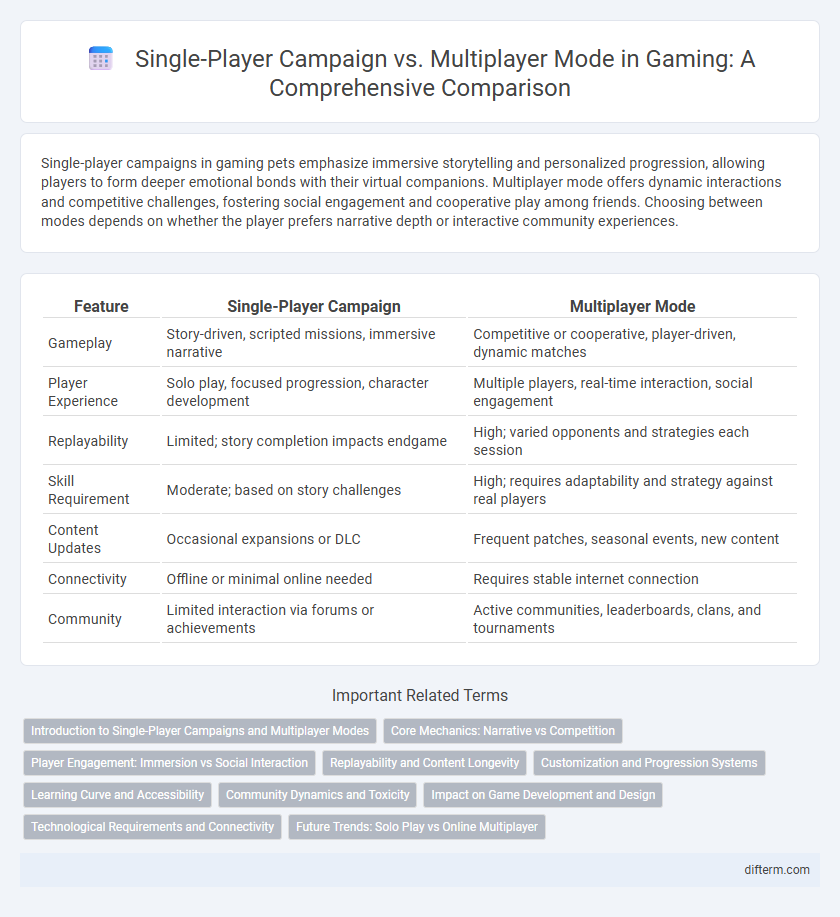Single-player campaigns in gaming pets emphasize immersive storytelling and personalized progression, allowing players to form deeper emotional bonds with their virtual companions. Multiplayer mode offers dynamic interactions and competitive challenges, fostering social engagement and cooperative play among friends. Choosing between modes depends on whether the player prefers narrative depth or interactive community experiences.
Table of Comparison
| Feature | Single-Player Campaign | Multiplayer Mode |
|---|---|---|
| Gameplay | Story-driven, scripted missions, immersive narrative | Competitive or cooperative, player-driven, dynamic matches |
| Player Experience | Solo play, focused progression, character development | Multiple players, real-time interaction, social engagement |
| Replayability | Limited; story completion impacts endgame | High; varied opponents and strategies each session |
| Skill Requirement | Moderate; based on story challenges | High; requires adaptability and strategy against real players |
| Content Updates | Occasional expansions or DLC | Frequent patches, seasonal events, new content |
| Connectivity | Offline or minimal online needed | Requires stable internet connection |
| Community | Limited interaction via forums or achievements | Active communities, leaderboards, clans, and tournaments |
Introduction to Single-Player Campaigns and Multiplayer Modes
Single-player campaigns deliver immersive storylines and carefully crafted gameplay tailored for individual experiences, emphasizing character development and narrative depth. Multiplayer modes prioritize competitive and cooperative interaction among players, fostering dynamic social engagement and replayability. Both modes offer distinct challenges and rewards, catering to diverse gaming preferences and enhancing overall game longevity.
Core Mechanics: Narrative vs Competition
Single-player campaigns emphasize immersive storytelling with rich narrative arcs and character development to engage players emotionally. Multiplayer modes prioritize competitive core mechanics, fostering strategic interaction and real-time challenges among players. The contrast highlights narrative depth versus dynamic competition as central elements defining each gameplay experience.
Player Engagement: Immersion vs Social Interaction
Single-player campaigns offer deep immersion through rich storytelling and character development, enabling players to connect emotionally with the game world. Multiplayer modes drive engagement by fostering social interaction, cooperation, and competition among real players, enhancing replayability and dynamic experiences. Balancing immersive narratives with interactive social elements is crucial for maximizing overall player engagement in modern gaming.
Replayability and Content Longevity
Single-player campaigns offer carefully crafted narratives and unique experiences that often conclude after one playthrough, limiting replayability. Multiplayer modes provide dynamic gameplay with variable player interactions that significantly enhance content longevity and keep the experience fresh. Games with balanced multiplayer features tend to retain player engagement far longer than those relying solely on single-player content.
Customization and Progression Systems
Single-player campaigns offer deep customization options that allow players to tailor characters, skills, and equipment to their preferred playstyle, enhancing immersion and personal achievement. Multiplayer modes prioritize progression systems that reward competitive skill development and cooperative teamwork, with unlockable gear and ranking tiers motivating continuous engagement. Both modes utilize progression mechanics but differ in pacing and personalization, catering to solo or social gaming experiences respectively.
Learning Curve and Accessibility
Single-player campaigns typically offer a gradual learning curve through structured tutorials and story-driven progression, making them more accessible for beginners. Multiplayer modes often demand quicker adaptation to complex mechanics and strategies due to unpredictable human opponents, posing a steeper learning curve. Accessibility in multiplayer relies heavily on community support and matchmaking systems to balance skill disparities and onboarding.
Community Dynamics and Toxicity
Single-player campaigns offer immersive storytelling and personalized gameplay without external social pressures, fostering a focused and stress-free experience. Multiplayer modes cultivate dynamic community interactions, which can enhance engagement but also expose players to toxic behavior such as harassment and griefing. Effective moderation tools and positive community initiatives are crucial for mitigating toxicity and maintaining a healthy multiplayer environment.
Impact on Game Development and Design
Single-player campaigns demand intricate storytelling, character development, and carefully paced challenges to create an immersive narrative experience, which heavily influences game design toward linear progression and scripted events. Multiplayer modes require robust network infrastructure, balance considerations, and scalable content to support dynamic interactions and competitive gameplay, pushing developers to prioritize real-time synchronization and replayability. Balancing resources between these modes impacts development timelines and design choices, often resulting in distinct technical and artistic approaches tailored to each player experience.
Technological Requirements and Connectivity
Single-player campaigns demand minimal connectivity, relying primarily on local hardware performance such as CPU speed, GPU capabilities, and storage capacity to ensure smooth gameplay. Multiplayer mode requires robust internet connectivity with low latency and high bandwidth to support real-time data synchronization and minimize lag during online interactions. Advanced networking protocols and server infrastructure are critical for maintaining seamless multiplayer experiences, contrasting with the standalone nature of single-player technical setups.
Future Trends: Solo Play vs Online Multiplayer
Future trends in gaming indicate a balanced rise in both single-player campaigns and online multiplayer modes, fueled by advancements in AI-driven narratives and cloud gaming technology. Enhanced single-player experiences will leverage adaptive storytelling and immersive VR environments, while multiplayer modes are evolving with cross-platform play and real-time social interactions. The growth of hybrid games that seamlessly blend solo and cooperative multiplayer elements highlights a shift towards personalized yet community-oriented gameplay.
single-player campaign vs multiplayer mode Infographic

 difterm.com
difterm.com